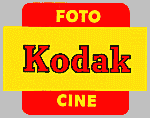
from Analog to Digital
You may feel I'm a stubborn old curmudgeon for holding out that long, until year-end 2005, but there are what I consider to be pretty good reasons. I don't care if you agree, but will explain anyway. May help understand the way I work without getting into tiresome highfalutin artistic discussions, too.
In the first place, what got me into photography was that I love messing around with chemicals. This main attraction has now disappeared. I kept developing my own stuff long after this, for most people, had become impractical. You have to time color film processing to the second with temperatures controlled to .2 degrees - Celsius, of course.
Way back when, and this may surprise you, in the early 1970s I already got fair warning from Modern Photography magazine that this revolution was going to happen. They predicted that, as one result, a roll of Ektachrome film would cost $120 by the year 2015. By now, I wonder if you can get the stuff at all by then! Farsighted indeed.
As an old fart already, I was the first photographer I know that wholeheartedly went digital, with my first
Hewlett Packard PhotoSmart scanner. It's still in use for all the 35mm work you find on these sites.
The one great advantage, I discovered immediately, was that it told Goodbye to All Dust.
Once you had scanned an original and spotted it, save it - and that's it. Great!

But changing over to a digital camera was another thing again. In the first place, my love for darkroom work. Well, I have to tell you, my claustrophobia somehow kept pace with the graying of my hair, so that love was long lost. Also, frankly, processing and printing color is no joy like B/W used to be. You can't influence the process, but just have to stick to the time-table or you have absolutely no way of knowing what results to expect. In effect, you're reduced to just feeding machines.
So far so good, but there were other considerations. Like the gamma range, say contrast ratio
, of digital versus film can still, in 2006, only be called inferior.
Viewfinder and screens: as far as I'm concerned, I hate people looking over my shoulder while I'm at work. I learned photography on view cameras, comfortably hidden away from spying eyes under a black cloth. To look at those tiny screens means I have to use reading glasses in the first place! If not a regular magnifying glass. Give me a break... It also cleverly forces you to hold the camera at arm's length, which is just asking for blur and shake.
Then, I have invested heavily in this range of Zeiss optics (the best schlock money can buy
). Zeiss still does not have a digital Contax, and that can only be because they don't feel like throwing away an entire range of lenses, lovingly developed over generations of successive designs, as long as there is no image chip that covers their size of 24x36mm. Zeiss even did not want to design Auto Focus lenses - I'm right with you, Carl and consorts. (They finally had to give up on that.)

Why I and Zeiss hate autofocus
Canon and Nikon just put up their lenses on the small chips. Let's go back in time a bit to explain:
After WWII, the USA just gave away the Zeiss patents they had acquired as spoils of war to companies like Canon and Nikon. Quite illegal, of course, but the USA won, right? All those lenses, and Contax range-finder bodies as well, were plagiarized. With one vital difference, and I'll try to avoid getting too technical. In defining the focal length of a lens, you have, like always in industry, a certain percentage of leeway. Now, it's cheaper to deviate from the
optically correctstandard 50mm lens and make a longer lens. The standard Zeiss lens is just that, 50mm. But many Japanese lenses put on the barrel 58mm - in practice, with a 10% leeway, they're more like 60-65mm.
Now you put a standard lens like that on a chip that's smaller than 24x36mm and the telephoto effect will grow even more pronounced. In these days when we look at monitors more than at prints, the use of the
standardlens is not that important any longer. What still is important, though, is the definition of the lens. Use only a portion of the image like that and you'll end up with less definition - no matter the highly touted 10 Megapixels of the chip I've seen listed in ads. (They finally stopped using that hype as they would have to change the lens standards to move beyond 8Mpixels; but only after Kodak took the trouble to explain that this was insanity.)
Then there's a delay between shutter release and actual picture taking. Absolutely hateful - how can you work like that? And nobody ever even mentioned it! Is this a hoax? A complot, even?! I had to find out for myself when I bought a digital camera and also a cell phone for Willy some years ago. (I hate cell phones - well, actually I hate any phone as much as Mark Twain did. Leave me alone every once in a while, just about sums it up. You ask my opinion, the invention of the phone was necessary only to get the Internet on the road.)

The trouble was that, gradually, it became harder and harder to get your film developed. After the proliferation of one-hour labs of around 2000, these just dropped out when the public went for digital. The last years whenever I had a roll developed it was full of dust, splotches and blotches, scratches and fingerprints.
Make the long story short, at that point Kyocera (Yashica) came out with an digital camera with a shutter delay of only 0.07". So I ordered it. Very nice feature here is a led-lit viewfinder (got myself rather spoiled with those Contax viewfinders), that stupid screen on the back OFF
by default. It's also much more affordable than those Nikons and Canons that, and this tends to make me ever so slightly paranoid, do not list their release delays - they only brag about their 4 FPS video speed. As if I'd be buying a movie camera!

Roxy (get it?)
For the time being, I guess I'll keep using this Kyocera
until Zeiss finds some chip maker that accommodates their lenses.
Early 2007 I bought a (similar) Panasonic Lumix DMC-FZ; ~ 6 Megapixels/Leitz 10* zoom.
What I Hate About This
Why, oh why, did they not follow the Panavision way? These guys built a video camera that handled just like their film cameras, so you know what you're doing when you switch over. This has encouraged a lot of those Old Masters to take the plunge.
Okay, so all those controls you find on an old-fashioned photo camera would have to be replaced by switches, which can get to be expensive. Still, the method of operating these things is so completely different from what you're used to. You do not merely have to get used to a new camera, you have to learn a completely different mode of operating it.
Then, I have no idea of my focussing distance, nor of my focal length and of my shutter speed. Let alone my depth of field. The camera lacks a manual focus control; and the worst part is, you're never really sure what it chooses to focus on. What really disgusts me is that you're just forced to discard a lot of your craftsmanship; there's no way you can put it to use.
To adjust for backlit situations, and all that sort of thing (there's much more) you really have to take out your instruction booklet — which means you have to carry a laptop along, as this comes on a CD in PDF format. Count your blessings. Hateful too is that automatic white balance - you shoot a sunset and all orange-red color effects are filtered out.
See what I mean? Filter the mood away!
(Antwerp quay)
I'll accept the fact that it contains a microphone and video possibility. Shooting video is a completely different trip from shooting stills.
But, after all, even though I pay for all that nonsense, I don't have to use it.
But That's All Over
Since then, I went all the way and bought a Sony Alpha-900
with a Zeiss Vario-Sonnar T-* 24-70mm F2.8 (what a rip)
plus a second-hand Minolta 75-300mm ($100 only)
plus a Loreal Stereo adapter.
Alltogether good for a hefty 3.5kg, at mine hage yet.
Most of the time I now schlepp around a Panasonic Lumix FZ40
with a 24x Leica optical zoom. Nice, small and light—but it takes many long seconds
to process an image, which can get very frustrating.
Asinine
All through my 'career' I have been fighting the clumsy fact that 'original' aspect ratios differ from print aspect ratios.
This results in compositions being ruined, people getting cropped out, you name it, when you have a print made.
You would think that, when they had a chance, they would change one of the two formats when going digital.
But no: they kept the very same mistake in.
The Greatest Loss
We have lost those marvelous black Kodak, transparent other brands, 35mm film containers.
I'm hanging on to those I still have around
Sure came in handy!

SEARCH this site or the Web

copyright notice
all material on this site, except where noted
copyright © by harrie verstappen , curaçao
reproduction in any form for any purpose is prohibited
without prior consent in writing

